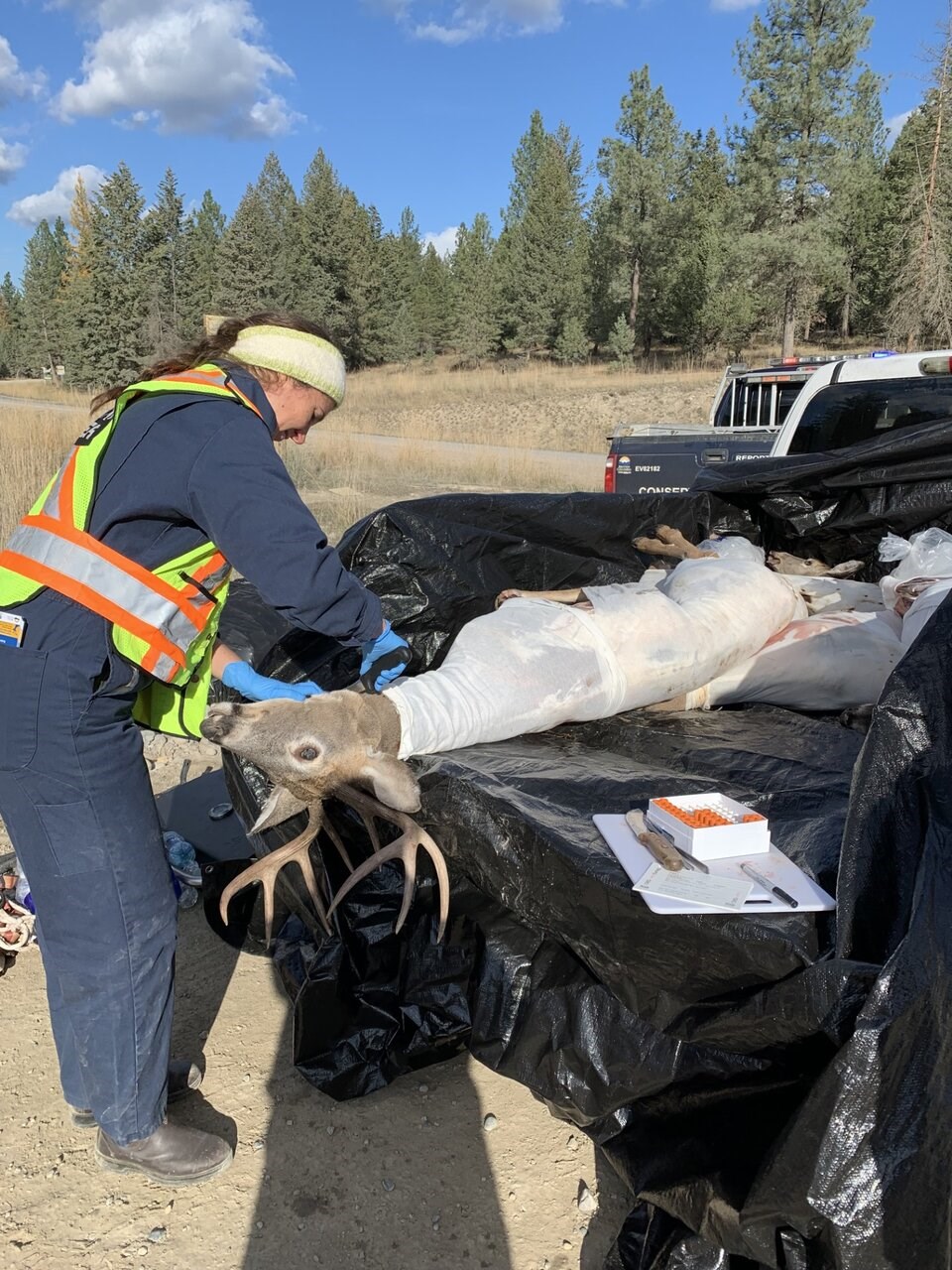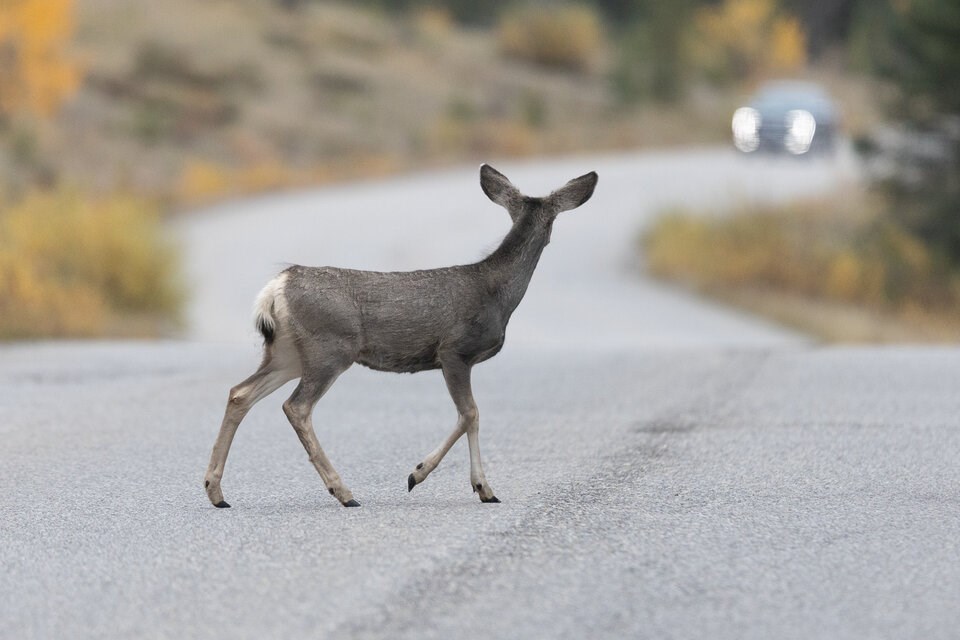The head of a B.C. government team tracking wildlife disease in the province said she is racing to understand how and where a new “zombie deer disease” is spreading.
Surveillance for chronic wasting disease (CWD) was ramped up after the of the disease were found in two deer in the Kootenays last week, said wildlife health biologist Cait Nelson a day after the discovery.
Nelson said her team is trying to assess potential animal corridors that could be spreading the disease, and how they cross over with towns, cities and roads. Once that's done, they plan to layer everything on a map to assess the risk of the disease spreading.
“One of the tricky things about chronic wasting disease is most of the animals don’t present any symptoms,” Nelson said. “A lot of them will look completely normal.”
A degenerative brain disease, CWD is spread in deer, elk, moose and caribou through infectious prions, deformed proteins that accumulate in the animal's body.
Within 18 months of infection, the animals can start showing signs of weight loss, drooling, and poor coordination.
“It is 100 per cent fatal. Every animal infected with this disease will die,” Nelson said.
Before a sick animal dies, it can spread the prions through feces, which get into the water and can be ingested by other deer.
Nelson says she hopes her team has caught the disease early enough to contain it, but that it’s still not clear how much the disease has spread. She says her team continues to work with hunters to try and isolate more samples.
Jesse Zeman, president of the BC Wildlife Federation whose hunters work with Nelson's team, said the two cases came from two separate species.
One positive sample came from a mule deer killed by a hunter; the other in a white-tail deer found as road kill not far from Cranbrook, B.C.
“We have two species of deer in two areas fairly far apart,” he said. “It means the problem is probably bigger than we think it is.”
“Until we have more samples, we won’t know.”

Zeman says the news has sent shock waves through the hunting community, and that it’s still settling in. He says hunters who rely on wild meat to subsist will now have to process and freeze animals for two to three months while they wait for test results to come back.
“It’s a big change,” he said.
A 2023 response plan for the disease includes a number of containment options. They include targeted hunting should clusters appear, educating hunters to properly dispose of carcasses, and measures to avoid spreading the disease around the province after the animal has been dressed and butchered.
Since its first discovery in 1967, the disease has been found in South Korea, Norway, Sweden, Finland and the United States. In Canada, CWD has been mostly isolated to farmed deer and elk, as well as wild deer, elk and moose, in Alberta and Saskatchewan.
No cases have ever been found in humans but some researchers say they have found worrying signs such a jump could be possible.
In August 2022, researchers at the University of Calgary carrying out experiments in mice found chronic wasting disease “might infect humans” and that “the presence of infectious prions in feces is concerning because if this occurs in humans, it is a source for human-to-human transmission.”
Last month, the Center for Infectious Disease Research and Policy out of the University of Minnesota announced it was launching an international effort to prepare for possible chronic wasting disease spillover event into humans or farm animals.
Nelson says research has so far not conclusively answered whether the spread to humans will ever happen. In livestock, she acknowledged there’s some evidence of the disease “pushing the species barrier” and passing to other animals.
“We don’t know everything about this disease,” she said. “That’s why they recommend not to eat the animal.”
One big unanswered question for conservationists is what it could mean for B.C.’s endangered caribou populations, especially since reindeer in Europe have died of the disease.
Eddie Petryshen, a conservation specialist with the Kootenay-based environmental group Wildsight, said the infected deer were found about 170 kilometres from the closest caribou herd in the central Selkirk mountains.
“But as we learned with pandemics, things can move very quickly. And it’s just really concerning for all wild ungulates,” he wrote in a message.
Nelson said her team has spent a decade monitoring other jurisdictions where the disease has caused devastation in wildlife populations, and that eradication is not realistic.
Successful management of the disease would mean keeping the number of infected animals below five per cent of the population. Over 20 per cent and populations start to decline, according to the government's CWD response plan.
“At that point, there are not really any management tools that will have an impact on controlling the disease,” Nelson said. “Over time, you would see declines in the population overall.”
To prevent that worst-case scenario, Zeman says B.C. should take a hard look at urban deer populations in the region, which he says have grown out of control and present a perfect vector for the CWD to proliferate.
“Once it gets in there, it’s going to take off. You’ll probably going to have deer dying in the city,” he said of Cranbrook. “British Columbia should have reduced these deer populations a long time ago. And now they’re going to have to.”
Zeman said his members have freezers set up to continue helping Nelson’s team source samples for testing. But as the disease continues to spread, more help is needed.
“The government of Canada is missing in action,” Zeman said. “They should have a federal chronic wasting disease strategy to help coordinate the provinces.”
“Now that we’ve got it, we have to throw a bigger net.”

